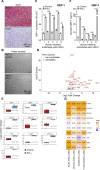Analysis of the interferon-γ-induced secretome of intestinal endothelial cells: putative impact on epithelial barrier dysfunction in IBD
- PMID: 37645250
- PMCID: PMC10460912
- DOI: 10.3389/fcell.2023.1213383
Analysis of the interferon-γ-induced secretome of intestinal endothelial cells: putative impact on epithelial barrier dysfunction in IBD
Abstract
The development of inflammatory bowel diseases (IBD) involves the breakdown of two barriers: the epithelial barrier and the gut-vascular barrier (GVB). The destabilization of each barrier can promote initiation and progression of the disease. Interestingly, first evidence is available that both barriers are communicating through secreted factors that may accordingly serve as targets for therapeutic modulation of barrier functions. Interferon (IFN)-γ is among the major pathogenesis factors in IBD and can severely impair both barriers. In order to identify factors transmitting signals from the GVB to the epithelial cell barrier, we analyzed the secretome of IFN-γ-treated human intestinal endothelial cells (HIEC). To this goal, HIEC were isolated in high purity from normal colon tissues. HIEC were either untreated or stimulated with IFN-γ (10 U/mL). After 48 h, conditioned media (CM) were harvested and subjected to comparative hyper reaction monitoring mass spectrometry (HRM™ MS). In total, 1,084 human proteins were detected in the HIEC-CM. Among these, 43 proteins were present in significantly different concentrations between the CM of IFN-γ- and control-stimulated HIEC. Several of these proteins were also differentially expressed in various murine colitis models as compared to healthy animals supporting the relevance of these proteins secreted by inflammatory activated HIEC in the inter-barrier communication in IBD. The angiocrine pathogenic impact of these differentially secreted HIEC proteins on the epithelial cell barrier and their perspectives as targets to treat IBD by modulation of trans-barrier communication is discussed in detail.
Keywords: IBD-inflammatory bowel disease; angiocrine; barrier; cytokines; endothelial; interferon; paracrine; secretion.
Copyright © 2023 Naschberger, Flierl, Huang, Erkert, Gamez-Belmonte, Gonzalez-Acera, Bober, Mehnert, Becker, Schellerer, Britzen-Laurent and Stürzl.
Conflict of interest statement
Authors MB and MM were employed by Biognosys AG. The remaining authors declare that the research was conducted in the absence of any commercial or financial relationships that could be construed as a potential conflict of interest.
Figures

Similar articles
-
Development, validation and implementation of an in vitro model for the study of metabolic and immune function in normal and inflamed human colonic epithelium.Dan Med J. 2015 Jan;62(1):B4973. Dan Med J. 2015. PMID: 25557335 Review.
-
Angiocrine Regulation of Epithelial Barrier Integrity in Inflammatory Bowel Disease.Front Med (Lausanne). 2021 Aug 2;8:643607. doi: 10.3389/fmed.2021.643607. eCollection 2021. Front Med (Lausanne). 2021. PMID: 34409045 Free PMC article. Review.
-
IFN-γ drives inflammatory bowel disease pathogenesis through VE-cadherin-directed vascular barrier disruption.J Clin Invest. 2019 Nov 1;129(11):4691-4707. doi: 10.1172/JCI124884. J Clin Invest. 2019. PMID: 31566580 Free PMC article. Clinical Trial.
-
Patients with inflammatory bowel disease (IBD) reveal increased induction capacity of intracellular interferon-gamma (IFN-gamma) in peripheral CD8+ lymphocytes co-cultured with intestinal epithelial cells.Clin Exp Immunol. 2001 Jan;123(1):15-22. doi: 10.1046/j.1365-2249.2001.01443.x. Clin Exp Immunol. 2001. PMID: 11167992 Free PMC article.
-
Interferon Gamma Counteracts the Angiogenic Switch and Induces Vascular Permeability in Dextran Sulfate Sodium Colitis in Mice.Inflamm Bowel Dis. 2015 Oct;21(10):2360-71. doi: 10.1097/MIB.0000000000000490. Inflamm Bowel Dis. 2015. PMID: 26164664
Cited by
-
Interferons in Colorectal Cancer Pathogenesis and Therapy.Dis Res. 2024;4(1):31-39. doi: 10.54457/dr.202401005. Epub 2024 Apr 23. Dis Res. 2024. PMID: 38962090 Free PMC article.
-
S1PR1-biased activation drives the resolution of endothelial dysfunction-associated inflammatory diseases by maintaining endothelial integrity.Nat Commun. 2025 Feb 20;16(1):1826. doi: 10.1038/s41467-025-57124-x. Nat Commun. 2025. PMID: 39979282 Free PMC article.
-
Intestinal tissue levels of anti-TNF alpha, antibodies, and cytokines in paediatric Crohn disease.Sci Rep. 2025 Jan 7;15(1):1138. doi: 10.1038/s41598-024-83858-7. Sci Rep. 2025. PMID: 39775097 Free PMC article.
-
IL-36/IL-36R signaling promotes CD4+ T cell-dependent colitis via pro-inflammatory cytokine production.Front Immunol. 2025 Jun 26;16:1604332. doi: 10.3389/fimmu.2025.1604332. eCollection 2025. Front Immunol. 2025. PMID: 40642091 Free PMC article.
-
Identifying inflammatory bowel disease subtypes: a comprehensive exploration of transcriptomic data and machine learning-based approaches.Therap Adv Gastroenterol. 2025 Aug 12;18:17562848251362391. doi: 10.1177/17562848251362391. eCollection 2025. Therap Adv Gastroenterol. 2025. PMID: 40808866 Free PMC article.
References
-
- Adinolfi M., Lehner T. (1988). C9 and factor B as acute phase proteins and their diagnostic and prognostic value in disease. Exp. Clin. Immunogenet 5 (2-3), 123–132. - PubMed
LinkOut - more resources
Full Text Sources

